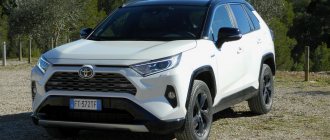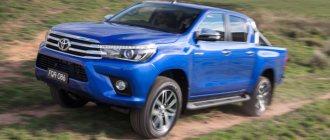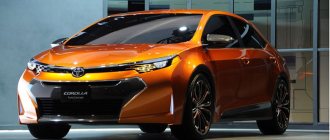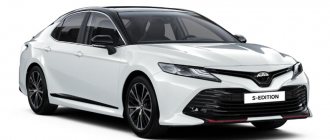About engines for Toyota RAV4
Toyota 1ZZ-FE/FED/FBE 1.8 l
engine The 1ZZ engine family was released in 1998 and replaced the outdated “A” series engines. In particular, the 1ZZ replaced the 7A, but with a lightweight aluminum cylinder block and cast iron liners. The timing belt drive was replaced with a chain. The engines now have an IFGR system on the VVTi intake. Forged connecting rods were used, plus lightweight valves, and in general the engine turned out to be long-stroke and low-end, which is perfect for the North American market.
The most common shortcomings include oil wasting due to imperfect oil scraper rings, but after 2005 this disadvantage was removed.
The 1ZZ is also characterized by knocking and noise due to stretching of the timing chain drive.
Floating speed can be removed by washing the throttle valve block and the XX valve.
If vibration occurs, you need to pay attention to the rear cushion of the unit.
According to the manufacturer, the 1ZZ engine is not repairable, and its service life does not exceed 200 thousand kilometers. 4-
Engine Toyota 1AZ-FE/FSE 2.0 l
The Toyota AZ engine family appeared on the market in 2000 and replaced the “S” series.
In particular, the 1AZ-FE/FSE engine became the successor to the popular 3S-FE/FSE, but unlike its predecessor, it did not have many modifications.
The new engines have a lightweight aluminum BC, a VVTi variable inlet gas distribution system and an electronic throttle valve are installed, and the FSE modification uses direct fuel injection. To reduce the load on the liners, the cylinder axis was shifted relative to the crankshaft axis.
Toyota 1AZ-FE/FSE 2.0 is characterized by thread failures in the cylinder head mounting block.
Vibrations also often occur at idle, which is a feature of the motor.
If the engine is jerking, it's time to clean the throttle body and carbon deposits in the intake manifold.
Overheating is also typical for Toyota 1AZ-FE/FSE 2.0 versions for the Japanese market, which will entail loss of body geometry and replacement of the engine with a contract one. 4-
Engine Toyota 2AR-FE/FSE/FXE
The 2AR-FE power unit appeared in 2008 and replaced the 2.4-liter 2AZ-FE. The aluminum BC received thin cast iron sleeves, the crankshaft with 8 counterweights is shifted 10 mm towards the exhaust and uses two balancer shafts. Lightweight pistons received a floating pin.
The cylinder head with two shafts is mounted on a three-layer metal gasket and has hydraulic compensators. The IFGR system is used on two Dual-VVTi camshafts. The timing belt uses a single-row chain drive.
Due to the fairly good design of the 2AR-FE engine, the unit has no obvious illnesses or design features.
Sometimes the pump leaks and the VVTi clutch knocks when cold.
In general, the motor is disposable, but reliable. 4
Engine Toyota 2GR-FE/FSE/FXE/FZE 3.5 l
The 2GR power unit was developed in 2005 on the basis of the 4.0-liter 1GR to replace the 3MZ-FE, reducing the piston stroke to 83 mm. The aluminum BC received cast iron liners, a cylinder camber angle of 60 degrees, lightweight T-shaped pistons and forged connecting rods.
The engine uses a timing chain drive, hydraulic compensators and an IFGR system on Dual-VVTi shafts at the intake and exhaust.
Toyota Rav 4 engines 4th generation
Toyota Rav 4 4 generations were equipped with the following engines :
2.0 3ZR-FE
A two-liter 3ZR internal combustion engine is used in the 4th generation Toyota Rav 4 in combination with a CVT or manual transmission . Main characteristics of the 2.0 Rav 4 4th generation engine:
The approximate service life of the Rav 4 2.0 3ZR-FE engine is 250 – 300 thousand km , and the factory warranty is given for 100 thousand km or three years . Oil consumption allowed by the manufacturer is limited to 1 liter per 1000 km.
The 2.0 3ZR-FE engine has no global problems. But there are disadvantages:
For reliable operation of the 2.0 3ZR internal combustion engine, use high-quality oil and fuel and change the lubricant in a timely manner.
Engine Toyota Rav 4 2.5 2AR-FE
Toyota Rav 4 with a 2.5 2AR engine in Russia is sold only with all-wheel drive and an automatic transmission . Characteristics of Rav 4 with 2.5 2AR-FE engine:
According to operational data, the service life of the 2.5 AR-FE Rav 4 engine is more than 300 thousand km , and the warranty period is one hundred thousand or three years . Toyota allows the Rav 4 2.5 2AR-FE engine to consume up to 1000 grams of oil per 1000 km.
The high reliability of 2.5 2AR engines is noted, subject to timely maintenance.
The disadvantages are as follows:
Diesel 2.2 2AD-FHV
The 4th generation Toyota Rav 4 also uses a 2AD-FHV diesel engine in combination with a six-speed automatic transmission and all-wheel drive . Main characteristics of Rav4 2.2 diesel:
The design of the 2AD-FHV internal combustion engine includes hydraulic compensators , which increase the overall level of reliability. The timing chain drive also does not cause any complaints. At the same time low fuel consumption in relation to engine power. Disadvantages:
About behavior on the roads and comfort in the cabin
Reviews of the 1998 RAV 4 are mostly positive. The car behaves briskly, handles well and holds the road. Areas where a passenger car needs to slow down are passed with ease. In the city, it jumps over all curbs without problems, and in winter, thanks to all-wheel drive, snowdrifts are not an obstacle at all. Disc and drum brakes with ABS system work effectively on any surface.
However, some drivers are dissatisfied with how the vehicle reacts to small irregularities off the asphalt.
According to them, it begins to shake and rattle. All the noise enters the cabin. If you park the car in the sand, then turning it out of it at first speed is quite problematic. In addition, the vehicle has a turning radius that is too large for the city.
As for the interior, it couldn't be simpler. From the driver's seat there is an excellent view through all the windows. The upholstery is made of ordinary but surprisingly durable material. The seats are not particularly comfortable, but they cannot be called uncomfortable either. Their main advantage is the ability to transform into a flat platform 1.2 m long.
Motors Rav 4 3rd generation
Toyota Rav 4 3 generations were equipped with 2.0 gasoline engines of two modifications : 3ZR-FE and 1AZ-FE. The crossover was also aggregated with a petrol 2.4 2AZ.
Engine Rav 4 2.0 1AZ
The two-liter Toyota Rav 4 series 1AZ-FE engine was installed from December 2008 to April 2010 . Parameters of Rav4 2.0 1AZ with four-speed automatic transmission and all-wheel drive :
The 1AZ engine, in comparison with other internal combustion engines, is characterized by high reliability and efficiency. But provided that very good fuel and oil are used.
But typical breakdowns also occur:
Engine 2.4 2AZ
Toyota Rav 4 3rd generation in the 2.4 AT Prestige Long configuration was equipped with a 2AZ-FE power unit in combination with a four-speed automatic transmission . The four-row internal combustion engine has the following characteristics:
With proper maintenance, the resource of the power unit will be more than 300 thousand km .
The manufacturer allows oil consumption up to 1 liter per 1000 km. Among the disadvantages of the ICE 2.4 2AZ are:
Options and prices
During the period of the official release of the 1st generation car, Toyota engineers managed to create over two hundred configurations. The cost is influenced by the following characteristics:
- body type – five- or three-door;
- transmission - manual transmission or automatic transmission;
- electronics – navigation system, front fog lights;
- body elements - rear and front spoiler, alloy wheels, roll bar;
- interior equipment and decoration;
- the presence of additional protective equipment - airbags, anti-lock system, seat belt limiters.
A 1998 Toyota RAV4 costs on the Russian market from 180 thousand rubles. The most frequent offers are versions in 3- and 5-door bodies at prices ranging from a quarter of a million to 350 thousand rubles. Very well-maintained models with tuning can be bought for half a million. The convertible is a rare guest in Russia.
Volumes and power of Rav 4 engines
In 1994, the world of motorists became acquainted with an unusual Japanese car. The mixture of a compact crossover and an SUV has drawn criticism. But soon the all-wheel drive recreational vehicle became the best in the J segment.
The users were young people and families with average incomes. Potential buyers are interested in the technical characteristics, service life of the Toyota RAV 4 engine, and cost.
Salon
Considering that the crossover was positioned as an inexpensive youth car, the interior has modest upholstery, no luxurious technical equipment, everything is extremely simple and at the same time comfortable. A clear and uncompromising dashboard made of rough, impact-resistant plastic, with a minimum of controls and additional functions. The dials are recessed, and the steering wheel is made to look like a sports car.
The ergonomics in the cabin are not bad. The driver and passenger on the right side have enough space, they are not constrained in their movements, and can easily reach the interior elements. In coupes and convertibles, access to the rear seats is especially difficult for larger passengers.
If necessary, the seats in the back can be folded out to create sleeping places, or folded down to increase space in the trunk.
The 5-door modification of Toyota differs slightly from the 3-door model. The key differences are:
- increased space for rear passengers;
- increased trunk volume;
- possibility to dismantle the back row.
After modernization in 1998, RAV 4 received a modern audio system, an electronic speed counter, and air conditioning. The front passenger seat is equipped with an airbag.
Engines installed on Toyota RAV 4
Over 25 years, Toyota Motor Corporation has produced 5 generations of RAF. Each was equipped with its own engines.
First generation – 1994-2000
The naturally aspirated engine was a 2-liter petrol engine. The power of the 3S-FE four was 135 hp. With. Another unit - 3S-GE - with the same volume developed 160-180 liters. With.
These are strong engines with economical fuel consumption. The curb weight of the car was 1,210-1,260 kg, depending on the modification. Fuel consumption was 13 liters per 100 km: the “merit” of all-wheel drive.
There was also an electric version of the power plant. It developed a speed of 129 km/h, and the car traveled 400 km on one charge. But it was not popular; such cars did not make it to Russia.
The engines were famous for their reliability. The disadvantage was the seals: oil leaked even from the gearbox.
Second generation – 2000-2005.
The most popular was the four-cylinder 1AZ-FE, index - D-4D, volume - 2 liters. The engine is equipped with a timing chain belt.
The car develops 147 hp. With. with a torque of 192 Nm. AI-95 fuel consumes:
The maximum speed of the car on the highway is 185 km/h.
Third generation – 2006-2013
The manufacturer offered a choice of gasoline engines:
The 2.4-liter engines are paired with four-speed automatic transmissions. The 2-liter version has a manual transmission.
Fourth generation 2013
RAV cars were equipped with two gasoline power plants: the RAV 4 2-liter 3ZR-FE engine corresponds to 146 hp. With.; new - 2.5 l 3ZR-FE - 180 l. With. The latest model works in tandem with a 6-speed automatic transmission.
Two cars received turbocharged diesel engines: 2 liters with a capacity of 124 horsepower, and the 2.2 liter 2AD-FTV marking shows 150 “horses”.
Fifth generation 2021
The engine volume of the RAV 4 2021 edition will be 2.0 liters, gasoline. Engine marking M20A-FKS, paired with a 6-speed manual transmission. Power - 149 hp. With. At the speed limit, the speedometer will show 190 km/h.
Motor A25A-FKS. Eight-speed automatic, 2.5 liters of volume. There is 199 hp under the hood. With.
Toyota RAV 4 1998: description
The car, created on the Toyota Corolla platform, combines the best properties of an SUV and a passenger car. The 1998 crossover is available in three different body styles: three-door, five-door and two-door convertible with a fabric roof. Depending on this, its external dimensions vary in the following ranges:
- length – from 3.7 to 4.1 m;
- height – from 1.65 to 1.66 m;
- width – 1.69 m;
- wheelbase - 2.2 or 2.4 m;
- weight – from 1.21 to 1.26 tons.
The three-door coupe seems too small and cramped in appearance. The rounded contours give it a slightly toy-like appearance. The bumpers and underbody are made of black plastic to protect the vehicle from external damage. Large windows in the front and sides provide good visibility for the driver. A spare wheel is placed on the rear door - the main attribute of SUVs of the 90s.
The 1998 version with two doors and a fabric roof received even more rounded shapes, a new radiator grille, and optics.
The model with a five-door body even in the photo looks quite grown-up. The crossover has become longer and more convenient for rear passengers due to additional doors, but the platform remains the same three-door.
Engine 2.0 petrol (3ZR-FE, 146 hp)
This engine has been produced in the Toyota RAV 4 since 2007. Four-cylinder solid block, distribution mechanism with 16 valves. Each cylinder has 2 intake and exhaust valves.
Two systems are installed:
The cylinder block is aluminum, the liners are cast iron.
The manufacturer indicates the estimated resource of the power unit is 250,000 km.
Toyota RAV4 Hybrid
The Hybrid crossover with a Toyota patented gasoline engine appeared in 2015. The Americans were the first to see it. A year later, the car became the best-selling car in its class. The hybrid powertrain is compared to Lexus.
The internal combustion engine with valve volume of 2.5 liters develops a torque of 279 Nm. The cars are equipped with electric motors. An independent rear motor produces another 67 hp. With. The total power of the hybrid engine is 199 hp. With.
The four-cylinder engine is paired with an automatic transmission. Torque goes to all wheels. Front wheel drive is always running. Rear - turns on automatically when the car is slipping.
The hybrid's variable transmission recharges the battery during braking. Electronics also contribute to this, so the battery is always well charged.
Fuel consumption in the combined cycle is 7.1 liters per 100 km. Acceleration to this mark is 8.3 seconds.
Nominal and actual motor life
Japan produces reliable engines. The timing chain is driven by a chain. Its resource is 150 thousand km. Those who have traveled such a distance note that the chain stretches and the operation of the vehicle becomes dangerous.
Owners of cars with a two-liter 1AZ-FE engine have already driven 300 thousand km. There are cases of 400 and 500 thousand kilometers. The engine has a huge service life.
The 3S-FE engine with a two-liter valve displacement has the same safety margin. This version does not have balance shafts. Therefore, when the timing drive breaks, the valves are not affected. The main thing for the driver is to notice the malfunction in time and, together with the drive, change the roller and pump.
When consumables (filters, seals, lubricants, antifreeze) are changed in a timely manner, the service life of the engine increases noticeably.
Turbocharged diesel engines travel 250-280 thousand km without problems. Next, the injectors need to be replaced. They are cleaned every 10-15 thousand mileage.
The service life of the engine is affected by poor fuel and engine overheating. The latest modifications have “disposable” blocks. They are lightweight, have other advantages, but cannot be overhauled. Therefore, their service life depends on objective reasons (fuel) and driver behavior. The owner of a RAV 4 can himself extend the life of the engine or shorten it.
About servicing RAV 4 1998
The machine is reliable, unpretentious and does not require high maintenance costs. But in order for it to run longer, it is necessary to regularly carry out adjustment work and maintenance:
- clean the fuel pump;
- check the battery, crankshaft;
- monitor oil and coolant levels;
- Check the condition of the air filter and all pipes for leaks.
And also change consumables in a timely manner.











